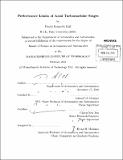| dc.contributor.advisor | Edward M. Greitzer and Choon Sooi Tan. | en_US |
| dc.contributor.author | Hall, David Kenneth | en_US |
| dc.contributor.other | Massachusetts Institute of Technology. Dept. of Aeronautics and Astronautics. | en_US |
| dc.date.accessioned | 2011-05-23T18:07:23Z | |
| dc.date.available | 2011-05-23T18:07:23Z | |
| dc.date.copyright | 2011 | en_US |
| dc.date.issued | 2011 | en_US |
| dc.identifier.uri | http://hdl.handle.net/1721.1/63042 | |
| dc.description | Thesis (S.M.)--Massachusetts Institute of Technology, Dept. of Aeronautics and Astronautics, 2011. | en_US |
| dc.description | Cataloged from PDF version of thesis. | en_US |
| dc.description | Includes bibliographical references (p. 111-114). | en_US |
| dc.description.abstract | This thesis assesses the limits of stage efficiency for axial compressor and turbine stages. A stage model is developed, consisting of a specified geometry and a surface velocity distribution with turbulent boundary layers. The assumptions and parameterization of the stage geometry allow for calculation of the magnitude of various loss sources in terms of eight input parameters. By (1) considering only the losses which cannot be eliminated (such as viscous dissipation within the boundary layer on wetted surface area), (2) selecting stage design variables for minimum loss, and (3) assessing performance in the incompressible limit, an upper bound on stage efficiency can be determined as a function of four stage design parameters. Under the given conditions, the maximum stage efficiencies are found to be 95.5% and 97.2% for compressor and turbine stages, respectively. The results of the stage analysis are evaluated in the context of gas turbine generator and turbofan cycles for different levels of material and cooling technology. If the cycle temperature and pressure ratios are selected for minimum fuel consumption, even small increases in component efficiency can lead to substantial increases in overall engine efficiency. For example, if the efficiency of components is increased from 90% to 95% and the design is optimized, the specific fuel consumption of a gas turbine generator and turbofan engine are reduced by 17% and 19%, respectively. The stage level and cycle analyses carried out imply that component efficiency improvements leading to an appreciable increase in cycle thermal efficiency still remain to be realized. | en_US |
| dc.description.statementofresponsibility | by David Kenneth Hall. | en_US |
| dc.format.extent | 114 p. | en_US |
| dc.language.iso | eng | en_US |
| dc.publisher | Massachusetts Institute of Technology | en_US |
| dc.rights | M.I.T. theses are protected by
copyright. They may be viewed from this source for any purpose, but
reproduction or distribution in any format is prohibited without written
permission. See provided URL for inquiries about permission. | en_US |
| dc.rights.uri | http://dspace.mit.edu/handle/1721.1/7582 | en_US |
| dc.subject | Aeronautics and Astronautics. | en_US |
| dc.title | Performance limits of axial turbomachine stages | en_US |
| dc.type | Thesis | en_US |
| dc.description.degree | S.M. | en_US |
| dc.contributor.department | Massachusetts Institute of Technology. Department of Aeronautics and Astronautics | |
| dc.identifier.oclc | 722792234 | en_US |
